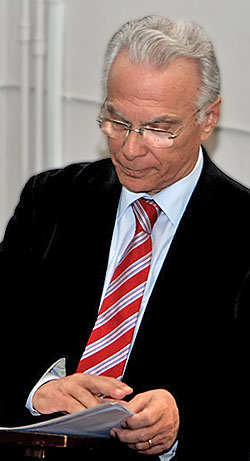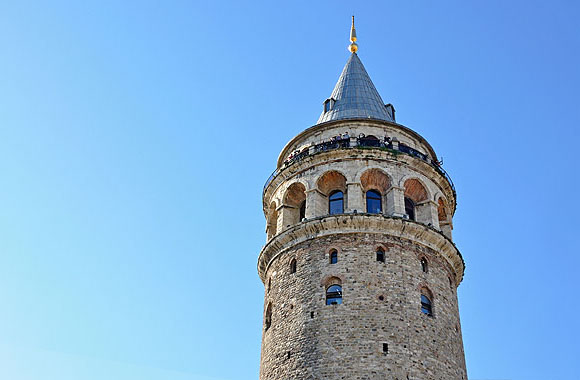Why the Great Synod of Orthodoxy is necessary today – 2
12 December 2015 The address of the professor emeritus of the Theology Faculty, which was given at the conference organized by the Monastery of Vatopaidi, in collaboration with the Patriarchal Institute of Patristic Studies and the Theological School of the Aristotle University of Thessaloniki, (3-5 December, 2015) on the subject ‘Towards the Holy and Great Synod’.
The address of the professor emeritus of the Theology Faculty, which was given at the conference organized by the Monastery of Vatopaidi, in collaboration with the Patriarchal Institute of Patristic Studies and the Theological School of the Aristotle University of Thessaloniki, (3-5 December, 2015) on the subject ‘Towards the Holy and Great Synod’.
2. The Holy and Great Synod and the unity of Orthodoxy
However, if Orthodoxy is to respond successfully to these challenges and if its discourse is to resonate in the modern world, it will have to present a united and single voice, overcoming any problems which have to do with the specific national features of the individual Orthodox Autocephalous Churches, which make it seem, to the outside world, fragmented and weak. The system of autocephaly, which is, of course, rooted deeply in the ecclesiological and canonical tradition of the Orthodox Church, should not work to the disadvantage of communion and cooperation between the individual Autocephalous Orthodox Churches in practice. Much less should it prove a cause of competition between them, especially in matters which affect the whole of Orthodoxy.

Galata Tower in Constantinople (CC Martin Holland)
From this point of view, this Holy and Great Synod is a unique opportunity and also the most appropriate means, from a canonical point of view, for the Orthodox Church to proclaim its unity and to express itself with a single voice to the modern world. At the same time, however- and this is equally deeply rooted in its ecclesiological and canonical tradition- it is also the sole and necessary instrument for overcoming any arbitrary behavior, which demonstrates a lack of Orthodox ecclesiological awareness, such as, for example, when certain autocephalous Churches decline to participate in actions which derive from decisions taken at the Pan-Orthodox level, or when they do not observe Pan-Orthodox decisions, which they actually co-signed, or when they even call into question the canonical boundaries between various autocephalous Churches. If we are to ensure the unity of Orthodoxy, all these problems can be dealt with and resolved only by the greatest synodal instrument, from a canonical point of view, which is a Holy and Great Synod of the Orthodox Church. Of course, the synodal system is indissolubly linked with the nature and the life of the Orthodox Church. But as the Ecumenical Patriarch recently pointed out, most appositely, even though this system has been and is observed to this day, more or less faithfully within the autocephalous Churches, it is almost completely absent in relations between Churches, the result being that an image is created of an Orthodoxy with many Churches, rather than one Church. This is totally unacceptable in terms of Orthodox ecclesiology[i]. It was for precisely this reason that, addressing the Primates of the Autocephalous Orthodox Churches, the Ecumenical Patriarch stressed the need to reinforce the institution of the synod beyond the boundaries of the individual autocephalous Churches, so that an awareness of one single Orthodox Church can be cultivated, a prospect to which the Holy and Great Synod could certainly make a decisive contribution[ii].
3. The agenda for the Holy and Great Synod
For all the above reasons, then, whether they are related to the challenges and problems faced by people today, or have to do with internal problems which affect the unity of Orthodoxy, the need to hold the Holy and Great Synod is obvious. This is why the agenda for the Synod, which has already occupied all the autocephalous Orthodox Churches for more than fifty years, at the preceding five Pan-Orthodox Pre-Synod Meetings (1976-2015), corresponds entirely to the above problems and challenges of our times.
Until the 4th Pan-Orthodox Pre-Synod Meeting (2009), the agenda for the Synod consisted of the following ten items: a) the matter of the Orthodox diaspora; b) autocephaly and the manner in which it can be proclaimed; c) autonomy and the manner in which it can be proclaimed; d) the diptychs; e) the calendar question; f) impediments to marriage; g) the importance of fasting and its observation today; h) relations between the Orthodox Church and the rest of the Christian world; the Orthodox Church and the Ecumenical movement; and i) the mission of the Orthodox Church in the modern world: the contribution of the Orthodox Church to the establishment of peace, justice, freedom, brotherhood and love among nations and the elimination of racial and other forms of discrimination. In the end, however, these ten themes were restricted to nine, since the Special Inter-Orthodox Committee which met in April 2015 decided that item number 9 (the Orthodox Church and the Ecumenical movement) should be subsumed into the 8th (Relations between the Orthodox Church and the rest of the Christian world), at the insistence of the Churches of Russia, Bulgaria and Georgia, which, for mainly pastoral reasons did not want a separate theme referring to the relations between the Orthodox Church and the Ecumenical movement.
It is clear that all the themes of the Holy and Great Synod refer to contemporary issues related either to the organization and the institutional expression of the unity of Orthodoxy (diaspora, autocephaly, autonomy, and diptychs); or to the preservation of Orthodox spirituality in combination with the contemporary needs of the Orthodox flock (calendar, impediments to marriage, fasting) or to inter-Christian relations (bi- and multi-lateral); or to the credible witness of Orthodoxy in the modern world (naturally, on the basis of the Christian ideals of peace, justice, freedom, brotherhood and love among nations)[iii].
Seven of these nine themes have already been discussed and completed at the preceding Pan-Orthodox Pre-Synod Meetings, at which the relevant texts were approved. These will be sent for comments and final approval to the Great and Holy Synod. Only two of the above nine themes, the issue of the manner of proclaiming a local Church as autocephalous and that of the order of commemoration of the Autocephalous Churches in the diptychs have encountered serious difficulties during the discussions, though, in the opinion of most of the Autocephalous Churches, this should not be an obstacle to the convocation of the Holy and Great Synod. There were also some of the above seven themes, such as those regarding the challenges and problems of the modern world (e.g. impediments to marriage, or ordinances on fasting) or those referring to relations between the Orthodox Church and the heterodox and the ecumenical movement whose texts were approved at the 2nd and 3rd Pan-Orthodox Pre-Synod Meetings (1982 and 1986 respectively). These will have to be brought up to date and modernized, given that the decisions made on these issues were taken some time ago, when different conditions obtained[iv]. To this end, a Special Inter-Orthodox Committee has been set up, which, at three successive meetings (2014-2015) has dealt with the updating and modernization of the texts in question, which, to allow their submission to the Holy and Great Synod, were approved at the 5th Pan-Orthodox Pre-Synod Meeting which convened at Chambésy, Geneva, from 10-17 October, 2015[v].
So from the point of view of preparation, all the necessary steps have been taken relating to the content and resolutions regarding the items under discussion, so that, God willing, the Holy and Great Synod will be able to begin its proceedings at Pentecost, 2016, with the aim of not only ensuring and expressing the institutional unity of Orthodoxy, but also of providing a credible and powerful witness ‘concerning the hope within us’ to the modern world.
Conclusion
Given what we have said, it should be clear, I hope that after a backlog of internal problems which date from decades ago and have affected the unity of Orthodoxy, and of pressing external challenges facing people today, and following the enormous preparations for this momentous event which have lasted more than fifty years, the voice of Orthodoxy, through the Great and Holy Synod, is extremely relevant and indispensable. I would like to bring my address to a close with the words of Metropolitan Damaskinos, the late Metropolitan of Adrianoupolis and formerly of Switzerland, at the conclusion of an article of his on the subject: ‘Through its convocation and proceedings, the Holy and Great Synod will contribute to the renewal and renown of the message of Orthodoxy, not only among the Orthodox faithful, but throughout the whole of Christendom. The hour of Orthodoxy has, indeed, arrived’[vi]
[i] .ibid
[ii] ibid
[iii] See His Eminence Metropolitan Damaskinos of Switzerland, «Η αγία και μεγάλη σύνοδος της Ορθοδοξίας», in Ορθοδοξία 2000: Παρελθόν – Παρόν – Μέλλον (Proceedings of the International Theological Conference, Athens 4-8 May 2000), pubd. By Apostoliki Diakonia, Athens 202, p, 385.
[iv] On this, see Th. A. Meimaris, The Holy and Great Council of the Orthodox Church and the Ecumenical Movement, Ant. Stamoulis Publications, Thessaloniki 2013, pp. 123 ff., 173 ff.
[v] See Ανακοινωθέν Ε’ Προσυνοδικής Πανορθοδόξου Διασκέψεως εν Σαμπεζύ Γενεύης, Εν Σαμπεζύ Γενεύης, τη 16η Οκτωβρίου 2015, at http://www.churchofcyprus.org.cy/print. php?type=article&id=5629.
[vi] See Metropolitan Damaskinos of Switzerland, op.cit. p. 391.






